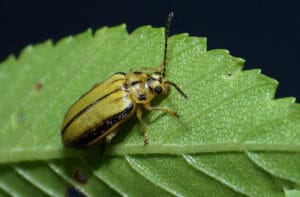Winter is on its way, but that won’t stop pests from trying to make their homes in the cracks and crevices of your trees. In this post we focus on Portland tree care and tree pest control in general. We provide tips on how to help trees resist pests, especially over the fall and winter seasons. As always, our focus at UFP is on green solutions. You can be assured that we will always do our best to promote green pest control methods that don’t rely on chemical heavy solutions.
Every backyard landscape is an ecosystem that includes many kinds of bugs, some beneficial, and others that our ISA certified arborists consider pests. Pesticides are not targeted; they typically harm the beneficial bugs as well as the pests. As such, they disrupt the balance of life forms in your landscape, dragging down the ecosystem’s health. The trick with pest control is to find a good balance. Usually, beneficial insects do a good job of keeping pests under control. By keeping your trees and other plants healthy, you can support beneficial bugs, so that they can battle pest populations.
The key to maintaining a healthy system is to give the organisms that live there what they need, including food, water, nutrients, and so forth. Trees become stressed at the end of the long, dry, summer. As leaves turn color early, and dead spots are revealed, it is possible for an arborist to see which trees are having problems. These plants have been stressed, which has made them more susceptible to disease and predators.
By ensuring that your landscape stays healthy over the dry summer, you can minimize stress as well as pest problems. Ensure that critical areas stay watered, and monitor for pests. If pest issues are discovered, our arborists recommend preventative or cultural controls. For example, if you see branches that have been damaged by pests and/or disease, it is best to prune these parts away before the problem can spread.
Another earth-friendly approach is to increase landscape diversity. Having several different kinds of trees and shrubs increases diversity in the overall habitat, and decreases the chance that pest problems will develop. It’s easy for pests to thrive in a monoculture; by bumping up diversity you can decrease the likelihood that pests will take hold.
Oregon Pests. Let’s take a look at common tree pests in the Beaver State. Tree pests usually fall into three categories: Sap-feeding insects, defoliating insects, and wood-boring insects.
- Aphids and scales. Aphids and scales are sap-feeding insects that secrete a sticky, shiny substance. These pests cause damage to leaves of trees and shrubs. Usually, they cause damage to leaves, causing them to turn yellow and die. It is possible for an aphid- or scale-infected tree to die if enough leaves are damaged. It is also common for aphids to spread fungal disease, eventually leading to tree death. Signs of aphid infestation include sooty mold, the presence of ants (who are farming the pests’ honeydew secretion), and curling leaves, often found alongside the shiny and sticky secretions. Most of our Pacific Northwest trees are susceptible to aphid and scale infestation, many with species-specific aphids or scales.
- Elm Leaf Beetle. The larvae of this beetle eat the juicy part of the leaves while leaving the skeletal veins in place. Adult beetles chew circular patterns in the leaves. Defoliation can occur, and sections of the infested tree can die back. These beetles can attack all species of elm. You should be on the lookout for skeleton leaves and shot holes. Also look for clusters of eggs, and larvae movement along the stem.
- Bronze Birch Bore Beetle. Adult bore beetles feed on birch leaves. The larvae, however, do the most significant damage as they dig into the bark, where they restrict the tree from distributing water and nutrients. Eventually, the tree may suffer dieback at the crown. If effects continue down the tree’s main trunk, death may occur. In an infested tree, you will see 1/8”, D-shaped exit holes that are created by the adult beetle as it leaves the larvae stage. If you see dieback in the crown of the tree, this is another sign that you have a bronze birch bore beetle infestation.
Fruit Tree Pests. The Pacific Northwest is a hospitable environment for fruit trees, with their own pest problems. The commonsense solution is to monitor and inspect your fruit trees and to know what level of pest infestation is acceptable, and when to take action. Integrated Pest Management practices seek to identify organic and ecologically friendly solutions before turning to the use of chemicals. When chemicals are needed, they are used sparingly, and in controlled situations. In this case, common pests and diseases are treated by the use of insect predators, and cultural management solutions. The use of organic pesticides is considered as well when dealing with controlling for fruit tree pests.
UFP Pest Control. We adore trees and are horrified when we see damage from insect fiends. Whereas some tree companies promise fast results by zapping pests with chemical kill-all applications, our Portland certified arborists are dedicated to less toxic solutions. Certain tree pesticides have been associated with massive declines in the bee population. The fact that these chemicals entering streams and rivers is also well documented. Organic pest control is effective and we are dedicated to using organic options first. We will only use chemical solutions after all others have been explored and exhausted. Give us a call today and we will talk with you more about what you can do to treat and prevent tree problems using organic solutions.
For more information on tree pests, check out our previous blogs on tree pest control methods, and creepy crawlies that infest Oregon trees.
[Photo by: Sarah Zukoff via CC License]
This post first appeared on https://www.urbanforestprofessionals.com